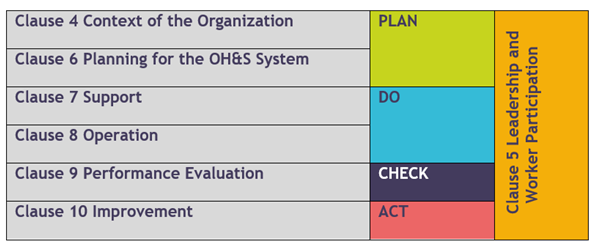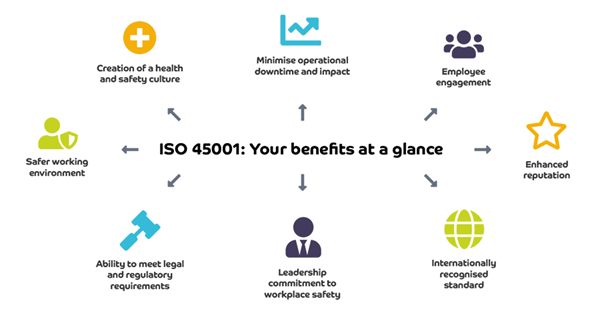ISO 45001 - Aimed at organizations that are serious about improving worker safety, reducing workplace risks, generating better, safer working environments.
What is ISO 45001?
Developed by national and international standards committees independent of government, ISO 45001 provides a standard for a Health & Safety Management system replacing the current standard (BS OHSAS 18001), which will be withdrawn in March 2021.
The standard provides a systematic approach for senior leadership to assess OH&S risk and opportunities, monitor and review safety performance, and set objectives for continual improvement within the ‘context’ of organisational activities.
A business is not required by law to implement ISO 45001 or other comparable management standards, but they can help deliver a structured framework for ensuring a safe and healthy workplace.
ISO 45001 applies to all organisations, regardless of size, industry, or nature of business. The standard is intended to be combined into an organisation’s current management system, with the same processes, and the same high-level structure as other ISO management system standards, such as ISO 9001 and ISO 14001.
How to implement ISO 45001
If you are thinking about implementing ISO 45001, here are a few guidelines to get you started:
- Complete an analysis of your organization’s framework that is relevant to OH&S (such as interested parties) as well as the internal and external factors that might impact your business.
- Determine the scope of the system, considering what you would like the management system to achieve.
- Set your OH&S policy and objectives.
- Define the time frame in which you wish to implement your system and plan how to achieve it.
- Determine any competence and/or resource gaps that need addressing before you can implement the standard.
The 10 Clauses of ISO 45001
The ISO 45001 standard uses a structure of ten clauses and follows the Plan, Do, Check, Act, (PDCA) model.
Clause1 Scope
This section sets the intent and parameters within which the ISO 45001 OH&S management standard can be used to attain its intended outcome.
Clause 2 Normative References
Reference to ‘normative references’ is common across all management system standards however, in the case of ISO 45001 there are no normative references.
Clause 3 Terms and Definitions
Clause 3 of the standard provides prescriptive terms of definition to prevent the wrong interpretation.
Clause 4 Context of the Organization
Section 4 requires each organization to analyse and understand the context of its activities, both externally and internally, and understand the needs of interested parties. Among other things, this will include understanding legislation, employee, stakeholder and shareholder requirements. It will also go a long way towards defining the scope of your OH&S management system.
Clause 5 Leadership and Worker Participation
The Leadership section encourages both management commitment and involvement from employees. For example, sharing tasks and responsibilities across the team can ensure that knowledge is shared, and multiple team members become proficient in running the system. This allows consolidation of the culture and reinforcing the importance of OH&S within the organization.
Clause 6 Planning for the OH&S System
Planning to avoid undesired outcomes such as failures to meet legislation or the risk of employee injury; and deals with objective-setting for the OH&S management system, and there are also requirements to document some aspects of this section. It is under Clause 6 of ISO45001 that Risk Assessments are addressed (ISO 45001 – Clause 6.1.2: Hazard Identification and Assessment of Risks and Opportunities
Clause 7 Support
Covers elements such as communication, competence and awareness and documented information as well as resources.
Clause 8 Operation
Operational controls and emergency preparedness and response are addressed in Clause 8. This clause is now more specific about outsourcing and procurement management, meaning that organizations must ensure that the responsibility for risk is retained by management and not passed on to contractors.
Clause 9 Performance Evaluation
Monitoring and measuring the OH&S management system performance, including compliance to legislation and internal audit results, is covered in Clause 9. This section also emphasizes that management must review the OH&S management system performance to ensure effective performance.
Clause 10 Improvement
The last clause sets out how an organization must ensure that continual improvement is derived from the OH&S management system. This can include dealing effectively with non-conformance and employing a good corrective action process.
Sections 1 to 3 of the ISO standard provide details on the scope of the standard, normative references, and explanations or terminology that help better your understanding of the standard, while sections 4 to 10 contain the requirements.
How does ISO 45001 relate to Plan-Do-Check-Act?
PDCA (Plan-Do-Check-Act) is an iterative, four-stage approach for continually improving processes, products or services, and for resolving problems. It involves systematically testing possible solutions, assessing the results, and implementing those shown to work. Its adoption in any management system should ensure that it continues to evolve and improve in its performance.
Diagram of PDCA (Plan-Do-Check-Act).

The diagram below shows how PDCA relates to the sections of IS0 45001.

Day to Day Management of ISO 45001
The design of the Management System needs to allow the organisation to comply with ISO 45001 as easily as possible otherwise its operation itself could lead to not meeting the standard. Systems such as BCarm which have PDCA at the core of their design can provide a more effective option than paper-based or electronic management systems. You can read more information on how BCarm specifically supports ISO 45001 here.
What are the benefits of ISO 45001?
ISO 45001 empowers organizations to put in place an occupational health and safety (OH&S) management system. This will support them, manage their OH&S risks, and improve their OH&S performance by developing and implementing effective policies and objectives.
- Internationally Recognised Standard – This allows you to easily comminate your approach to Safety in the Workplace with and other parties with which your organisation engages, such as supply chains.
- Ability to meet legal and regulatory requirements – ISO 45001 can help you to establish operational controls which take into account risks and opportunities, as well as legal and other requirements.
- Leadership Commitment to Workplace Safety - The standard provides a systematic approach for senior leadership to assess OH&S risk and opportunities, monitor and review safety performance and set objectives for continual improvement within the ‘context’ of organizational activities. Implementation is a demonstration and commitment from senior leadership to internal and external stakeholders of the intent to protect workers from accidents including short- and long-term ill health effects. This commitment also provides assurances to the Board of Directors, Trustees or owners that management controls regarding OH&S risks inherent within the organization.
- Safer Working Environment - the standard will help you to determine hazards and the health and safety risks associated with your activities; seeking to either eliminate them or put controls in place to minimise their effects.
- Creation of a health and safety culture, whereby employees are encouraged to take an active role in their OH&S - the OH&S management system helps organizations to increase employee awareness of risks, and promotes workers to take an active role in health and safety matters. Besides reinforced leadership commitment to proactively improve OH&S performance.
- Minimise operational downtime and impact – workplace accidents have wider impacts than just the incident itself, whether financial or operational.
- Employee Engagement – there are strong correlations between H&S and high levels of Employee Engagement. Organisations with high levels of Employee Engagement evidence high levels of many performance metrics such as Turnover Growth, Profitability and Workplace Accidents to name a few. Read more.
- Enhanced reputation - Achieving certification to this standard is a recognition that you have achieved an international benchmark, getting you noticed by customers who are concerned about their social responsibilities.
 A diagram to show ISO 45001: Your benefits at a glance.
A diagram to show ISO 45001: Your benefits at a glance.
Are there alternatives to ISO 45001?
Adopting a large formalised management system approach may not be the most appropriate model for your businesses, particularly if it's small or low-risk. 'Managing for health and safety (HSG 65)' may help your organization as it provides a clear process-based approach to risk management.
Implementing the standard will benefit your organization and demonstrate compliance with health and safety regulation. But, in some respects, it goes further than what the law requires – best practice.
To implement ISO 45001 in a balanced way, auditors or certifiers must appreciate that it needs to be:
- personalised to an organization's size and level of complexity, and
- in proportion to the risks
The certification body should be accredited by either the United Kingdom Accreditation Service (UKAS) for ISO45001 or an equivalent accretion body.
If you are already certified to OHSAS 18001, you will have some of the essential tools and systems in place to implement ISO 45001.
How does BCarm support ISO45001
You can read more information on how BCarm specifically supports ISO 45001 here.
More information on ISO 45001
For more advice and help on ISO 45001 or to arrange a discussion click here.











